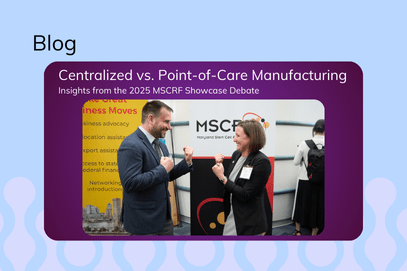RoslinCT Blog Series: Scientific Advisory Board Perspectives
Ken LeClair, RoslinCT SAB Chair
The Future is Non-Viral – Part 1
A manufacturing evolution is underway. Cell and gene therapy developers are exploring a range of viral vectors and non-viral vector alternatives for the delivery of therapeutic cargoes into cells. In the first installment of this two-part blog mini-series, Ken LeClair, Ph.D., Chair of RoslinCT’s Scientific Advisory Board, shares insights about the need for cargo delivery options, the challenges of viral vector production, and discusses nonviral genetic transposition systems.
Sustaining a Therapeutic Effect
The choice of vector for cellular reprogramming depends on the specific disease and intended therapeutic approach. Once delivered into the target cells, some viral and non-viral vectors are not reproduced with every cell division; vector levels per cell diminish, and the therapeutic effect can wane over time. Redosing might be needed, but the inactivation of vectors by pre-existing or newly initiated innate and adaptive immune responses can reduce therapeutic potential.
Viral and non-viral vectors that integrate therapeutic constructs into cellular genomic DNA in a semi-random, nontargeted location have been employed to achieve a longer-lasting effect in the engineered cell. The site of integration is a safety concern, however, because integration at certain locations can increase the risk of tumor development. More advanced vector technology platforms are being developed that can integrate genes and therapeutic constructs into precisely defined genomic locations. This targeted insertion can be controlled using modified gene editing components (e.g. CRISPR Cas and other gene editing systems), and a strategy, such as guide RNA, to target the insertion to a specific genetic locus.
Depending on whether the gene therapy or the engineered cell product needs stable integration of a therapeutic gene, or if transient expression is adequate or is used for safety reasons, different non-viral vector formats can be used. These non-viral approaches can also help minimize the high cost, complexity, and other liabilities of viral vectors.
Viral Vectors Paved the Way
Although several cell therapies and gene therapies that rely on viral vectors have been approved and are on the market, the production of clinical-grade viral vectors is a very complex and lengthy process. Viral vector manufacturing campaigns increase overall product development timelines and are a significant contributor to the high costs of some approved cell and gene therapies.
“Viral vectors have been incredibly helpful in enabling the development of gene therapies and for reprogramming cells. Unfortunately, the production of clinical grade viral vectors is complicated, requires several intermediate materials and the entire manufacturing process must be performed in a costly controlled environment,” noted Dr. LeClair.
Although some innovative viral vector manufacturing platforms are being developed, the typical method of production requires multiple plasmid DNAs delivered into a transformed mammalian cell line to initiate a biological process that leads to virus particle production. Viral particles are harvested and purified from a wide range of impurities. If residuals are not adequately removed, further processing may be necessary, or a complete repeat of the entire manufacturing campaign could be required. Viral vector yields are also variable from batch to batch and some batches can have insufficient titers of infectious viral particles.
“In addition to the high costs, complexity, and uncertain yields of viral vector manufacturing, there is an upper limit of how much therapeutic DNA can fit into a viral vector particle. This size restriction can complicate or prevent the design of effective viral vectors for certain applications. In contrast, there are non-viral vector systems that do not have such strict size constraints. The larger capacity of non-viral vectors can enable the incorporation of safety switches and additional functional elements into the therapeutic construct”, said Dr. LeClair.
Genetic Transposition Systems
Non-viral genetic transposition systems can be used to achieve stable integration and long-lasting expression of therapeutic transgenes. Transposition works by delivering the transposase enzyme and its corresponding transposon into target cells; the enzyme recognizes specific short nucleic acid structures (inverted terminal repeats, ITRs) that are designed to flank the therapeutic transgene that will get integrated into the genome. The transposon is a double-stranded DNA construct that contains a 5’-end ITR, the therapeutic transgene, and the 3’-end ITR. Other functionalities can be added to the transposon construct because there is no strict size limit, in contrast to viral vectors. The transposase/transposon complex enters the cell nucleus and semi-randomly inserts the therapeutic gene(s) located between the ITRs into the genome.
Progress has been made in developing ways to use transposition to deliver therapeutic constructs into preselected genomic locations. Insertion of the therapeutic construct into an appropriate natural locus can achieve better physiological control of expression levels and more sustained therapeutic effects.
Dr. LeClair points out that manufacturing the two components used in non-viral transposition is much simpler compared to the production of viral vectors and should reduce development costs and timelines.
“In fact,” he notes, “the transposase component remains constant from project to project and can be aliquoted and stockpiled in convenient amounts. The transposase function can be provided by delivering a synthetic mRNA to cells or could be the recombinant transposase protein itself. However, it is important to limit the amount and duration of functional transposase in the cell nucleus as a safety consideration to avoid genotoxicities that can be caused by repeated transposon insertion, removal, and successive re-insertion events. Too many insertions/excisions can cause chromosomal instability and oncogenesis, which must be avoided.”
To change to a different therapeutic product, only the transposon that carries the product-specific transgene construct would need to be manufactured at clinical grade. Nanoplasmid DNAs (npDNAs) are becoming popular as the format of the transposon component. The npDNA is easy to manufacture with high quality and at large scale and lacks some of the innate immune activating elements (e.g. ‘CpG’ motifs) that are present in the backbones of standard plasmid DNAs.
Transposition systems have been used for therapeutic cell product manufacturing for years. Several biotech companies are using Sleeping Beauty, piggyBac, TcBuster, pBac, T-Integrate, and other transposition platforms to manufacture cell products for evaluation in clinical trials. Except for some leukemias likely caused by some processing operations in one Australian trial, to date there have been no safety signals using transposition-based reprogramming in clinical trials.
In Part 2 of this blog mini-series, Dr. LeClair will highlight the use of physical and chemical methods for non-viral vector delivery in the production of a gene therapy or an engineered cell product.


